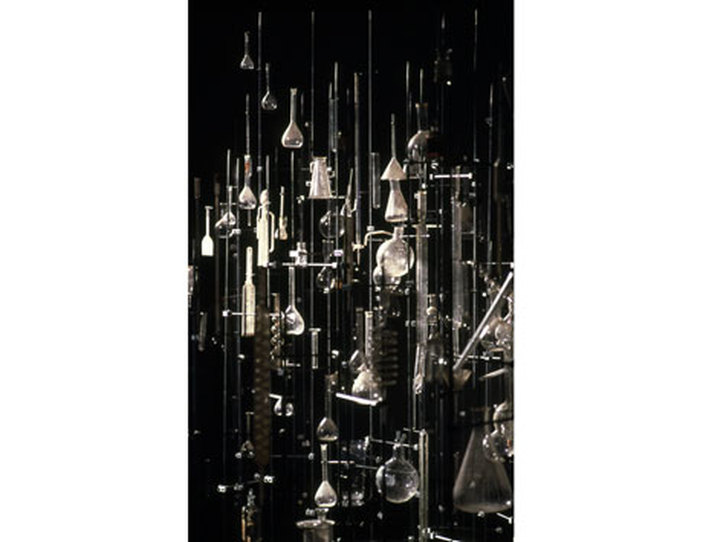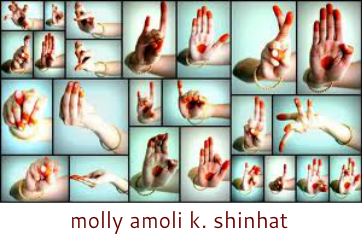Pneuma, Ruth Chambers & Prelude, Mary Kavanagh
SAW Gallery

Prelude, Mary Kavanagh. Image copyright www.marykavanagh.ca
Walking through Pneuma, 1998, I feel her presence in the trees, her breath in my breath. Among the fragile lungs, bronchia and ribcages, light falls through electronic leaves playing across my skin. She is there—the greatest of all Great Aunts, our Aunt Lucy.
Australopithecus afarensis, also known as "Lucy", is the most complete skeleton of the Hominid species. Lucy's 3.5 million year-old skeleton was unearthed in 1974 in the Laetolil Beds near Hadar, along the Rift Valley in Ethiopia ("Lucy in the Sky with Diamonds" was on the site's radio when she was found.). A tender 25 years old at her death, her shortness (just over a meter) belies her weight, metaphysically, as one of our earliest ancestors.
At eye-level, artist Ruth Chambers rigs up sixteen sets of lungs and ribcages. Dappled light from a single slide projection and short video wash across this hanging garden of chests. As light refracted through oceans or rivers or microscopic cell imagery, foliage is the video's subject, and the slide, though abstract, looks like magnified animal fur.
Unfired clay and paper lungs, ribcages and inverted small tree-branches hung near the walls invoke an endangered African landscape. The magnificent ever-changing quality of light that Chambers creates makes for a powerful, visceral and spiritual installation, in part because viewers are encouraged to "enter" the field of "Pneuma".
"A way to make that abstract viewpoint more accessible to people is the body," says Chambers. The act of breathing "brings the soul, the spiritual and the physical together."
While signifying on a direct level the bronchia inside our lungs, these branches reference the branches of trees, families, banks, tributaries of rivers, or deltas. They are caravan routes where all kinds of deposits and trades can be made along the way.
Organic material bones, trees, water, tissue—offers relief in our sanitized technologically driven culture, although the electronic projections, ironically, are critical to "Pneuma"'s creation. The combination feels primeval, a metaphysical dig unearthing bones of untold antiquity and unknowable origin.
The lungs and the rib cages are treasure chests, fragile storehouses of our breath and our stories. Fundamentally, the origin of all human storytelling is speech. Without breath, how can storytelling continue?
"The lungs are the perfect metaphorical objects, historically," says Chambers, from her teaching office in Saskatchewan. "Air was understood to be this magical substance, giver of life, not a tangible material thing." Even though, she adds, in our poisoned environment, today we now know different.
"I always used to sneak down to my grandparents' basement into this forbidden territory," says artist Mary Kavanagh, of the laboratory in her grandparents' Toronto home. " Both trained chemists, her grandfather worked in a winery while her grandmother went on to have ten children. Built from a dream to do their own research, the basement lab, chemicals and instrumentation lining the walls, began in the 60s. At its dismantling years later, Mary Kavanagh inherited the glass.
Made up of two parts, "Balance", 1998 a set of her grandparents' scales installed on a shelf, and "Distillation: in her element", 1998, Kavanagh's "Prelude" takes up the theme of memory on a very different tangent.
"How do we assert self-knowledge in the face of dominant authoritative systems of knowledge, like medical knowledge?" Kavanagh's questioning centers on science and its application based on social ideologies.
A massive collection of beakers, tubes, bottles, droppers and other science-related glass paraphernalia stretches up about 10 foot high, precariously held together by thin metal rods with points at both ends.
"It's a feat of engineering," says Kavanagh of the beautiful glass and fragile construction, "A counterpoint to the roundness and unpredictability of the glass. The tapering of the steel rods - it's evocative of medieval imagery, fragility, tools or weapons."
"The dust on the objects became evidence of use," she adds, Yet the dust coating and a long-dead spider in a beaker also reek of disuse.
Shrouded in the grimy evidence of time's passage, this glass palace conversely illustrates a departure. While Mary Kavanagh venerates her inherited glass, "Distillation" removes it from a living tradition. The glass is reduced to objectification in an exhibition, no longer used as originally intended.
"The glass became symbolic of a scientific tradition," says Kavanagh. "That particular method of research has become obsolete—it's not the dominant system anymore."
Published in The Ottawa Xpress, 2000
Australopithecus afarensis, also known as "Lucy", is the most complete skeleton of the Hominid species. Lucy's 3.5 million year-old skeleton was unearthed in 1974 in the Laetolil Beds near Hadar, along the Rift Valley in Ethiopia ("Lucy in the Sky with Diamonds" was on the site's radio when she was found.). A tender 25 years old at her death, her shortness (just over a meter) belies her weight, metaphysically, as one of our earliest ancestors.
At eye-level, artist Ruth Chambers rigs up sixteen sets of lungs and ribcages. Dappled light from a single slide projection and short video wash across this hanging garden of chests. As light refracted through oceans or rivers or microscopic cell imagery, foliage is the video's subject, and the slide, though abstract, looks like magnified animal fur.
Unfired clay and paper lungs, ribcages and inverted small tree-branches hung near the walls invoke an endangered African landscape. The magnificent ever-changing quality of light that Chambers creates makes for a powerful, visceral and spiritual installation, in part because viewers are encouraged to "enter" the field of "Pneuma".
"A way to make that abstract viewpoint more accessible to people is the body," says Chambers. The act of breathing "brings the soul, the spiritual and the physical together."
While signifying on a direct level the bronchia inside our lungs, these branches reference the branches of trees, families, banks, tributaries of rivers, or deltas. They are caravan routes where all kinds of deposits and trades can be made along the way.
Organic material bones, trees, water, tissue—offers relief in our sanitized technologically driven culture, although the electronic projections, ironically, are critical to "Pneuma"'s creation. The combination feels primeval, a metaphysical dig unearthing bones of untold antiquity and unknowable origin.
The lungs and the rib cages are treasure chests, fragile storehouses of our breath and our stories. Fundamentally, the origin of all human storytelling is speech. Without breath, how can storytelling continue?
"The lungs are the perfect metaphorical objects, historically," says Chambers, from her teaching office in Saskatchewan. "Air was understood to be this magical substance, giver of life, not a tangible material thing." Even though, she adds, in our poisoned environment, today we now know different.
"I always used to sneak down to my grandparents' basement into this forbidden territory," says artist Mary Kavanagh, of the laboratory in her grandparents' Toronto home. " Both trained chemists, her grandfather worked in a winery while her grandmother went on to have ten children. Built from a dream to do their own research, the basement lab, chemicals and instrumentation lining the walls, began in the 60s. At its dismantling years later, Mary Kavanagh inherited the glass.
Made up of two parts, "Balance", 1998 a set of her grandparents' scales installed on a shelf, and "Distillation: in her element", 1998, Kavanagh's "Prelude" takes up the theme of memory on a very different tangent.
"How do we assert self-knowledge in the face of dominant authoritative systems of knowledge, like medical knowledge?" Kavanagh's questioning centers on science and its application based on social ideologies.
A massive collection of beakers, tubes, bottles, droppers and other science-related glass paraphernalia stretches up about 10 foot high, precariously held together by thin metal rods with points at both ends.
"It's a feat of engineering," says Kavanagh of the beautiful glass and fragile construction, "A counterpoint to the roundness and unpredictability of the glass. The tapering of the steel rods - it's evocative of medieval imagery, fragility, tools or weapons."
"The dust on the objects became evidence of use," she adds, Yet the dust coating and a long-dead spider in a beaker also reek of disuse.
Shrouded in the grimy evidence of time's passage, this glass palace conversely illustrates a departure. While Mary Kavanagh venerates her inherited glass, "Distillation" removes it from a living tradition. The glass is reduced to objectification in an exhibition, no longer used as originally intended.
"The glass became symbolic of a scientific tradition," says Kavanagh. "That particular method of research has become obsolete—it's not the dominant system anymore."
Published in The Ottawa Xpress, 2000

